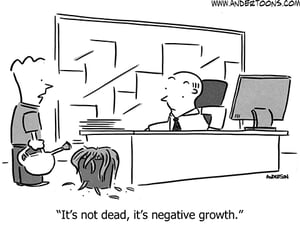
I have enough money to live comfortably for the rest of my life... If I die next Thursday.” - anonymous
I’ve been told , more times than once, “I do not plan to retire” or worse, “I have no plans to retire and I am not considering even thinking about retiring for the foreseeable future.”
But just because you will never retire, “never” does not mean you forget about goals and metrics to judge your success. And that is just what this article is about, The Earliest Possible, Maximally Strategic Date to Die
Your business is not perfect (whose is?) but your business needs you to make it at least perfect enough. How long do you need to hang on before you correct all of your “grave” errors? That is what you will learn below.
That’s right. Read on and when you are finished, you will have computed the number of months you must remain above ground.
But first, who is this dark dissertation not for?
Sadly, this article is not written for those already bereft of life. One would think this obvious, but you would be mortified to learn how many times the “SURVIVED-BYs” of the newly defunct have approached me to engage with them and their beloved unanimated in strategic planning.
And if you were born after 1969, this article is not for you. You are still under the delusion that the Grand Concierge has no check out time for you. The best plan for you and your loved ones is to buy lots of term life insurance and take up dangerous hobbies.
So then how do we do it, calculate the earliest possible, maximally strategic time to join the Choir Invisible? We look at what drives a business and what guides a business.
So, for all of you who are “I-will-retire-when-they-cart-me-out-on-a-stretcher-types”, this article is for you and your family, or at least your family.
Business Drivers
When it comes to evaluating your business, it is easy enough to try to reinvent the wheel.
Stop complicating things.
When viewed more simplistically, your options become much clearer, and it will be easier to address missing opportunities. So, what are the catalysts for just about any business?
They are:
- Finance
- People
- Systems and processes
- Marketing and Sales
- Products and Services
Whether or not you are looking for the ideal time to strategically take a final bow, it's vital that you have a keen understanding of how each of these areas impacts your business.
So here we go; The Strategically Important Steps to take before becoming a small plot of land owner
Let's Look at Finance First
A quick and easy metric used in measuring financial strength is: “Days-To-Bankruptcy”. For those business owners soon to be shuffling off their mortal coil, the “Days-To-Bankruptcy” (DTB) should be no less than three years.
Generally, after you have arrived on those heavenly shores, those you leave behind will spend three years screwing things up. By that time, one would hope, they would have figured out cash flow and sales cycles.
But few of you, soon-to-be trumpet cleaners, have a business with financial strength to last three years after you have decamped to farther shores.
![]() The grim calculation
The grim calculation
- Calculate your less than optimal DTB and then subtract your DTB from 36 months.
(see examples in the Exit/Transition Readiness Assessment) - To that result, multiply by 3 to arrive at the months now needed to implement the current plan to reach a DTB of 36 months.
- To account for the vagaries of business cycles divide the result by 12. If the result is 4 or more, add 48 months.
What About People?
 Whether they are family or not, you refer to them as random Oxygen Consumers, the talent that your company has will play a role in its longevity and ultimate survival. The best ways to analyze this driver is by taking a look at your Talent GAP.
Whether they are family or not, you refer to them as random Oxygen Consumers, the talent that your company has will play a role in its longevity and ultimate survival. The best ways to analyze this driver is by taking a look at your Talent GAP.
When you perform your People/Talent GAP analysis, you'll want to look at the Talent on hand vs. Talent needed for your business.
Use this formula:
(Talent Needed - Talent on Hand)/Talent Needed.
If the figure is higher than 20%, you have an issue that needs to be addressed.
For example, you determine that your company needs 50 talented people, but only has 30. This is a 40% deficit, which means no early grave for you. Start thinking about how much fun it will be running your business as the inevitable decrepitude sets in.
Either create a plan to address this shortfall, with the goal of filling a specific number of vacancies per month or start planning to spend your golden years behind your desk…alone.
![]() The grim calculation
The grim calculation
Every business needs a Leader, a Visionary, a Strategists, a Brilliant Tactician, a Marketing Guru, a superstar sales person, a nerdy IT guy and a Steve Jobs like innovator;
Compare your team’s talent with the roles above. They do not need to be great, they just need to be 80% as good as you. Think of grooming what you have versus hiring anew.
If your Gap is higher than 20%, allow for 2 months of planning and 24 months of recruiting or growing those you have.
THE FAMILY ADJUSTMENT: For every family member working in your business add 2 months each. If any of those relatives are your children, add 6 months each.
Your Systems and Processes
How do you currently manage your company? Do you have a "fly by the seat of our pants" style or do you "manage by walking around"? While there is something to be said for making some decisions on the run, this isn't a recipe for long-term business success.
Since there isn't a one size fits all metric for this, we'll make one up. The best gauge is how you compare to other companies in your sector. If there isn't a benchmark survey for your industry, create one. (We use the annual surveys from PSMJ) Typically, you will want to know what percentile your firm is in comparison to others in the survey. (Be sure to weigh different factors according to their importance.) If you're in the top quartile , you're golden. If you fall outside this range, either put your strategic planning hat on now to focus on improvements or start writing your business obituary with the strategic date of your demise well into your declining years.
![]() The grim calculation
The grim calculation
- If your website has not been refreshed and updated in the last two years, it’s old.
- Nobody hosts their own data. We are all on the cloud.
- A system to keep up with your systems is necessary.
- No one actually uses their mobile phones for making calls. The rudest thing you can do to another human being is to leave them a voicemail.
- Quality customer service is not provided by humans but by state-of-art ERM systems
Compare your operational and financial results to those of your peers and results.
- If you are in the 2nd quartile, start now upping your game and you might get where you need to be in 36 months.
- In the 3rd quartile you will now need another 36 months.
- Being in the 4th quartile and you are hopeless. Your business cannot run as it is without out you. Resign yourself to be the cranky old bastard that everyone thinks is just in the way
How About Marketing and Sales?
 What business can survive without sales? For your company to keep breathing, you either need to sell more, sell for more, or sell to more. Any of these three options will grow your revenue, and all three would be the trifecta.
What business can survive without sales? For your company to keep breathing, you either need to sell more, sell for more, or sell to more. Any of these three options will grow your revenue, and all three would be the trifecta.
Let's say you are growing your revenue figures, but the question is - are you growing them enough? Similar to systems and processes, you can gauge your performance by comparing it against two things:
- The economy
- The industry.
For example, GDP growth in 2018 was 2.9%, but it's only expected to be 2.5% for 2019. This is modest growth at best, so hopefully, you can match this.
Now, if you are in the IT space, the bar is raised. Quarterly growth for IT companies reached as high as 13.4% in 2018.
Choose your benchmark and then figure out whether your growth is measuring up. If not, are your growth numbers growing? If you are falling short, take a look at those three factors that can boost revenue and see what you can do to keep your business from crossing the River Styx anytime soon.
Remember, playing catch up with growth is an exponentially difficult task. If you are growing at 2% per annum and the rest of the nearest competitors are growing at 2 1/2 %, after two years your company is behind not 1 %, it is behind 1.0225%. And the longer you wait to create a plan and to implement, it only gets worse.
![]() The grim calculation
The grim calculation
Plan on a minimum of six weeks to make a plan and 18 months to implement. Can you start right away? If not, the more time you delay the more time delays will take. Spend no more than 4 months scratching your --- and picking your ----, old-timer, otherwise your years tending toward chemical equilibrium will be spent trying to get your old customers on the phone and wondering why no one picks it up.
Your Products and Services
The only constant in business is change. Yes, it sounds trite, but being inflexible with your company's products and services will create your own personal doomsday scenario.
The most successful organizations are those that continue to innovate and remain nimble as the needs of their customers change and the market shifts. This is tough to measure quantifiably, but you should still try.
As a metric, create a detailed questionnaire that analyzes your company's investment in technology, preparation for AI, and nimbleness. Rate yourself on a score of 1 to 10 on each and then evaluate the final score.
If the score is anything less than 7, it's time to make some changes. Put together a plan that you'll complete before that Days-to-Bankruptcy meter hits zero.
![]() The grim calculation
The grim calculation
- Make a hard deadline!
What Are Your Business Guiders?
Your business might be everything to you, so it is vital to know what guides your success in addition to those drivers we just identified. As you already know, there are plenty of ups and downs when owning and running a company. But, what do you really need to have for your business to avoid either a long, slow death or something much more sudden and unpleasant?
Some of the biggest factors that will guide your business into the future include:
- Vision
- Strategy
- Structure
- Culture
What is Your Vision?
Does your company have a vision? If so, is it clear or muddled? Fresh or outdated? Widely known or a secret?
Vision might begin with top management, but it won't be achieved there. Everyone in the company needs to internalize the company's vision, and goals should align with it to create a formula for success.
This is less difficult to measure than it seems. Write out your vision and then other department goals underneath. Do they align? Was the vision even consulted first?
If the answer is "no," you will want to make a few changes before you get to the next driver.
A Winning Strategy or a Dud?
Your company's strategies are shaped by both internal and external forces. Internal forces include your vision, profit goals, and even office politics. External forces include markets, laws, competition, technology, and customer needs.
Keeping track of all of this can be a tall order, but it is a must if you want to ensure success. An outdated strategy that fails to adapt to those forces we just listed will be a dud.
To measure how you are doing with this, create a scorecard. List your strategies for the past year, what forces influence them (internal and external), and score your success in achieving goals. In other words, did you blow past your goal by 20% or fail to meet it by 10%?
Do You Have the Right Structure?
If you're an established business, you've already chosen a legal entity. But is it the right one? Someone who began as a sole proprietorship and then grows over several years might want to take a second look. There may be tax benefits to choosing a different structure.
On the other hand, you might have the perfect legal structure but have a dysfunctional organizational structure. For example, a more bureaucratic functional organization might not work with a tech company that is trying to be more nimble.
Obviously, you should have some type of structure. But, evaluate this by putting it down in black and white. This might be another instance in which a confidential survey with a rating scale would provide insight. This will tell you whether you have smooth sailing ahead or are wearing a pair of cement shoes.
Every Company Has a Culture
Whether your company's culture is one of innovation and inclusiveness or closed-door tyranny, it's impacting your bottom-line results - good or bad. Depending on your company's size, there are a few ways to analyze your culture.
If you are large enough, check out your online reviews. Current and former employees will let the Net know what they think. Otherwise, send out an anonymous (it has to be this way) survey about culture to get candid feedback.
Use the information you receive to make positive changes (we can all do better) to the internal workings of your organization.
These business drivers and guiders should give you an idea about whether your business is heading towards an early grave or something more promising. But evaluating something you love and are immersed in day in and out can be a tall order. If you just can't wrap your head around these metrics or would like a fresh set of eyes, we can help.
Finding the right Business Guiders is simple but not easy. - (To paraphrase President Reagan.)

The “You” that you once were will not be easy to find. Among the many skills you would seek in a leader, this one must be able to abide a doddering old dodger like yourself as you spend your dotage doing what you should have done a dozen or so years ago.
Even NOT retiring requires a Plan for Never Retiring
This is why we created the Exit/Transition Readiness Assessment, to help you make a plan. Even if you didn't have a transition strategy when you started your business, you can create one now.
Whether you have decided it’s time to quit or not, begin planning your exit immediately so that you understand your options and control your financial future.
Happy to Help!
At Hunter & Associates, P.A., we provide professional advisory and consulting services that are structured to fit your needs. Whether you need operations, financial, restructuring, organizational, or some other form of consulting, contact me now to learn how we can help you achieve your goals.
Be sure to download the free Exit Planning Workbook:




